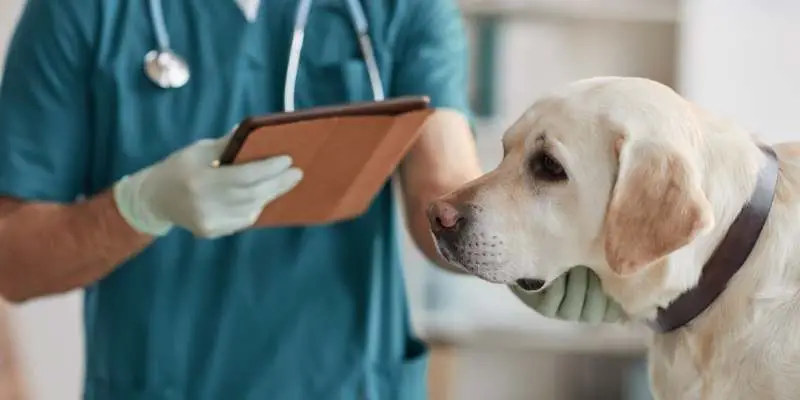Suppose your dog hasn’t been very active recently, urinates more frequently than usual, vomits, or loses appetite. In that case, it could be due to various factors (such as bacterial or viral infection), the most common of which is a liver illness, which could prove to be life-threatening if not treated on time. So, in any such case, the best course of action for you is to get medical advice from your veterinarian.
The liver’s primary role in a dog’s body is eliminating waste and toxins while also producing bile to aid digestion. So, when the liver is in trouble, it cannot fulfill its essential functions, resulting in the accumulation of toxins and wastes. It can lead to many other major health problems.
So, if you find your dog showing any of the above-mentioned symptoms, take him to a veterinarian to be examined and treated as soon as possible. The right treatment and proper medication will help your dog recover quickly and get back to its usual self.
Do you have a specific question about feeding a dog with liver problems? Then use the table of contents below to jump to the most relevant section. And you can always go back by clicking on the black arrow in the right bottom corner of the page. Also, please note that some of the links in this article may be affiliate links. For more details, check the Disclosure section at the bottom of the page.
Here's what we'll cover:
How to get a dog with liver disease to eat?
Having said all that, now you’re probably thinking about what to feed a dog with liver problems to help him, or her recover as quickly as possible. Right? Don’t fret. I’ve got all the info you must know regarding your dog’s liver disease.
Firstly, don’t be stressed if your dog refuses to eat or shows signs of reduced appetite due to liver disease; you may have to force him to take his food in this situation. Getting proper nutrients and calories becomes even more critical at this point to make sure your dog makes a speedy recovery.
As a result, you can use a syringe or even a feeding tube to ensure that your dog gets the proper nutrients.
Regardless of how severe or moderate your dog’s liver illness is, diet plays a significant role in disease control. Therefore make sure to feed your dog on time using a syringe or a feeding tube. And, of course, once your dog shows signs of improvement, it can resume eating normally.
What do you feed a dog with liver problems?
Before getting into the specifics of the food that should be provided to a dog with liver problems, keep in mind that the food must be fresh. This relieves the symptoms of liver illness and increases your dog’s chances of survival.
Also, gradually modify his diet rather than changing your dog’s diet all at once, which would upset his stomach.
Before you set up a food plan that’s considered perfect for dogs with liver illness, make sure you get a nod of approval from your veterinarian since this is equally crucial for your dog’s health.
Dogs with liver disease are fed a low-protein diet to help the liver eliminate toxins and other harmful wastes from the body. That’s because protein produces ammonia which burdens the liver.
Organic meats like beef and chicken, for example, are an excellent alternative for dogs with the liver disease since they contain no hormones or pesticides that can harm the liver.
Also, fiber absorbs excess ammonia and promotes the growth of beneficial bacteria that helps the liver cleanse itself. That’s why foods high in fiber, such as broccoli, beet pulp, and other vegetables can help your dog’s liver function better and recover faster.
But make sure you cook these vegetables well before serving them to your dog since they can’t digest raw vegetables well.
Nonetheless, vegetables like sweet potatoes, peas, and maize are heavy in sugar. Therefore, they should not be added to your dog’s diet. However, green beans and carrots can be served in a limited quantity. Still, before feeding your dog any of these foods, approve it from your trusted vet.
Foods bad for dogs’ liver
Foods rich in copper, salt, and Vitamin A such as duck, lamb, salmon, pork, leafy greens, sweet potatoes, legumes, nuts, and liver meats are not ideal for dogs with liver illness because they are harsh on the liver.
A higher intake of copper food creates a copper build-up in a dog’s body. It makes it difficult to digest the food and thus leading to liver failure.
However, before making any changes to your dog’s food, speak with your veterinarian first. They will help you choose the proper diet for your dog based on the severity of its liver illness.
Homemade food for dogs with liver disease
Pasta salad is one of the simplest dog foods for liver disease that’s easy to cook and includes high-quality ingredients that your dog would enjoy eating.
Ingredients
- ½ packet of frozen carrots
- ½ packet of frozen broccoli
- ½ pack of pasta
- 2 hard-boiled eggs
- 1 cup of brown rice
- Eggshell or bone meal for calcium (make sure to get the vet’s approval)
Preparation
First, cook the pasta, veggies, and brown rice separately and then combine them. Then cut or mash the boiled eggs and place them in another bowl. Now combine all of the remaining ingredients in a large dish, and your dog’s food is ready to serve.
This is one of the quickest meals you can serve to your dog with liver problems. Moreover, it also includes cooked vegetables that are rich in vitamins and minerals and are also easy to digest
However, getting a nod of approval from your vet is a must before incorporating these meals into your dog’s diet.
Homemade treats for dogs with liver disease
Below is one of the quickest and easiest to cook meals for dogs with liver disease that isn’t just healthy and helps treat senior dog liver problems. So let’s dig straight into the recipe.
Ingredients
- 1 egg
- 1/2 cup of oatmeal
- 1/2 cup of canned pumpkin (no additives added)
- 3/4 cup of chicken
- 3/4 cup of cottage cheese
Preparation
First off, chop the chicken into small pieces to make it easy for your dog to chew. Then either bake it or boil it and then put it aside.
Next, cook the oatmeal separately, most preferably according to the recipe on the box, and then boil the egg.
Once done, mix the egg, chicken, and oatmeal, and then add the remaining ingredients, and you’re done.
The recipe for this particular meal includes cottage cheese, which will enhance your dog’s digestive system and allow his body to produce less ammonia. Besides, oatmeal contains soluble fiber, which helps remove ammonia from your dog’s system. The eggs are a great source of protein and are ideal for your dog’s liver.
Again, consulting with a certified vet before adding this meal to your dog’s diet is highly recommended.
What is the best food to feed a dog with liver problems?
Foods rich in protein are considered best for your dog’s liver support diet. If you want to increase the protein intake of your dog, animal-based proteins are the best. Why so? Because they include a considerable amount of amino acids, which are beneficial to your dog’s overall health, particularly his digestion. These include chicken and turkey (without the bones), fish, and eggs.
Besides, Dairy products such as cottage cheese, goat cheese, and yogurt are also great.
Omega 3 fatty acids also top the list of best hepatic diets for dogs, fish oil and flaxseed oil being the ideal fats among all.
Furthermore, you can add fruits such as blueberries, figs, seedless watermelon, and papayas to your dog’s liver disease diet.
How can I help my dog with liver problems?
The first step in helping your dog with liver problems is to have your pup examined by an experienced veterinarian. Then, to ensure that your dog makes a speedy recovery, follow their recommendations and nutrition plan completely.
Also, avoid forcing an abrupt diet change on your dog because this may upset his stomach and bring him more harm than good.
And what is even more critical is their feed time. Try to split your dog’s mealtime, and instead of feeding your pet large meals two times a day, try cutting it down to 4-5 times a day with smaller portions of the meal.
This lessens the strain on their stomach and their liver gets to process less amount of nutrition, which is very important in the recovery process.
Thanks for the blog graphics: Canva.com

Thanks for the blog graphics: Canva.com
Doghint.com is a participant of several affiliate programs. The list includes (but not limited to) the following: VigLink, Refersion, ShareASale, and Amazon Services LLC Associates Program, an affiliate advertising program designed to provide a mean for us to earn fees by linking to Amazon.com and affiliated sites. Doghint.com does not intend to provide veterinary advice. All published articles are meant for informational purposes only and not substitute the professional veterinary consultation.


